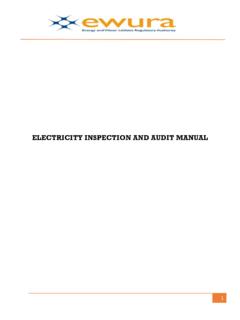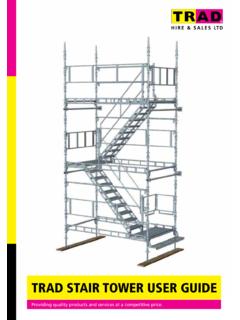Transcription of GUIDE TO - AWRA
1 GUIDE TO. FLEXIBLE WORK. Background The Australian Mines and Metals Association (AMMA). AMMA is Australia's national resource industry employer group. Since 1918, AMMA has been delivering superior workforce services to Australia's resource industry. As a member-based organisation, our vision is to ensure Australia's resource industry is an attractive and competitive place to invest, employ people and add value to the nation's wellbeing and living standards. AMMA's vast membership covers employers in every allied sector of this diverse and rapidly evolving industry, directly and indirectly employing more than half a million people across the Australian resources, related construction and allied services sectors. In addition to its consulting services and advice, AMMA works with its powerful network of likeminded organisations, professionals and experts to represent the resource industry on federal and state policy matters, achieving significant outcomes for all resource employers.
2 With a national presence and the most specialised resources industry knowledge in Australia, members of AMMA. can be assured their views on all industry and workplace matters are heard. The Australian Women in Resources Alliance (AWRA). AWRA is a national workforce gender diversity initiative delivered by Australia's resource industry employer group, AMMA. In 2011, AWRA was formed in response to the growing aspirations of AMMA members to increase the representation of women at all levels in their organisations. AWRA's charter is to assist employers on their gender diversity journey with the overarching goal to increase women's participation in the resources, allied and related construction sectors to 25% by 2020, thus delivering a diverse mix of skills and talent to drive productivity and innovation in Australia's resource industry. AWRA facilitates programs and provides support and guidance materials that help employers attract, retain and develop female talent, build their gender diversity capability, become an employer of choice for women and realise the advantages of a gender diverse workforce.
3 Through these support programs, AWRA can help you navigate the challenges of workforce diversity to achieve positive outcomes. Australian Women in Resources Alliance Strength through workforce diversity 2. Welcome AMMA and the Australian Women in Resources Alliance (AWRA) are pleased to present this GUIDE to Flexible Work for the use and benefit of mining, oil and gas, construction and supply chain employers linked to Australia's resource industry. The resource industry is traditionally male dominated, with women comprising 15%. of the workforce as of 2016. As AWRA works toward having women represent 25%. of the resource workforce by 2020, assisting employers with the implementation of flexible work practices to support their organisational diversity is critical. While this GUIDE focuses on flexible work in relation to gender, it's important to note that diversity encompasses many other demographics including age and culture.
4 You may wish to use this GUIDE to assist with other types of workforce diversity strategies. Steve Knott I also encourage you to consider how this workplace flexibility GUIDE could be utilised AMMA Chief Executive alongside other AWRA programs and initiatives designed to assist you in your diversity journey. Thank you for choosing AMMA and AWRA as your preferred partners in achieving valuable workplace diversity outcomes. On behalf of the Australian Government I am delighted to endorse the AWRA GUIDE to Flexible Work as an important practical tool to assist in the workplace flexibility practices of Australia's resource industry employers. With the jobs of the future set to be more flexible and agile, the ability for employers in male dominated industries to implement valuable and practical options for workplace flexibility will be vital to their success in attracting and retaining more diverse workforces.
5 Through our partnership with the Australian Mines and Metals Association (AMMA). and its AWRA initiative, collectively we are helping remove barriers for women to enter the resource industry, and in particular increase their representation in on-site and Senator the Hon. operational roles. Michaelia Cash Minister for Employment As Minister for Women and Minister for Employment, I passionately believe in women having the same career opportunities as men and that no sector of our economy Minister for Women should be more difficult for a woman to succeed in than a man. Minister Assisting the Whether you are at the start, middle, or well advanced in your diversity journey, I hope Prime Minister for the AWRA's GUIDE to Flexible Work assists your organisation in achieving its diversity Public Service objectives and contributing to greater workforce participation across a diversity of occupations and industries.
6 First published in 2016 by the AMMA, Australian Mines and Metals Association GPO Box 2933. Brisbane, QLD, 4001. Email: Website: ABN: 32 004 078 237. AMMA 2016. This publication is copyright. Apart from any use permitted under the Copyright Act 1968 (Cth), no part may be reproduced by any process, nor may any other exclusive right be exercised, without the permission of the Chief Executive, AMMA, GPO Box 2933, BRISBANE QLD 4001. Australian Women in Resources Alliance Strength through workforce diversity 3. How to use this GUIDE AWRA's GUIDE to Flexible Work is designed to provide resources, related construction and allied services sector organisations with a comprehensive knowledge base on workplace flexibility that can be considered for, and adopted to their workplaces. AWRA has compiled extensive research from a number of expert sources across industry, government and not- for-profit organisations that specialise in workplace flexibility arrangements.
7 Recognising that many resource industry workplaces are unique and complex, this GUIDE is intended to provide you with information to assess the viability of various flexible work arrangements and the tools to introduce those which suit your work environment. The GUIDE contains the following information sections: Overview: Providing an introduction to the importance of workplace flexibility and what it means for resource industry organisations. The process of flexibility: A general GUIDE for management in considering and implementing workplace flexibility arrangements within their organisation. Types of flexible work: Detailing 13 specific types of flexible work arrangements, including key considerations and example policies for your organisation's use. Case studies: Useful examples of how various resources and related sector organisations have incorporated flexible work practices within their workplaces.
8 Templates: For use as a guideline when seeking to adopt and incorporate different types of flexibility arrangements into your workplace. This information should be used to complement and build on existing tools and information your organisation may already have on workplace flexibility. You can use this material to analyse the current workplace flexibility capacities of your organisation and assess new options for added flexibility offerings. As you browse this information, think about how your management decision-making process and organisational culture might need to be addressed to support flexible work. DISCLAIMER: The Australian Mines and Metals Association (AMMA) and the Australian Women in Resources Alliance (AWRA) is dedicated to providing you with information you can practically adapt to your unique workplace environment. The material and advice contained in this GUIDE is of general nature.
9 Readers are not obliged to adopt any of the information, strategies and guidelines provided. If you are unsure about how it applies to your situation please contact us at or on 1800 627 771. Produced March 2016. Australian Women in Resources Alliance Strength through workforce diversity Table of contents 1. Overview 6.. The rise of workplace flexibility 6.. Flexible work in the Australian resource industry 6.. Making flexibility work 7. 2. The process of flexibility 8.. Case Spotlight: Refusing a flexible work request 9.. Legal Spotlight: Individual Flexibility Agreements (IFA) 9.. Legal Spotlight: Flexible Work and the National Employment Standards 10.. Further considerations for your flexibility process 11.. Legal Spotlight: Discrimination 13. 3. Types of flexible work 16.. Part-time work 17.. Reduced hours 18.. Casual employment 19.. Job sharing 20.. Results-Only Work Environment (ROWE) 21.
10 Working on location | away from home 22.. Telecommuting | teleworking 23.. Legal Spotlight: Telecommuting/flexplace and work health and safety considerations 24.. Compressed working hours 25.. Flexible working hours 26.. Purchased leave 27.. Expanded leave 28.. Shift work 29.. Phased retirement 30. 4. Case studies 32. 5. Useful templates 36. 6. Bibliography 46. Australian Women in Resources Alliance Strength through workforce diversity Overview The rise of workplace flexibility Workplace flexibility involves employees and employers agreeing on when, where and in some cases how long work activities are undertaken. Such arrangements offer employees the ability to balance their work-life goals, while also providing employers with greater flexibility to help meet changing operational needs. Although not a new concept (for many years the need for greater flexibility in work was primarily driven by senior businesswomen), the Global Financial Crisis (GFC) of 2008 rapidly brought these human resources strategies mainstream.



